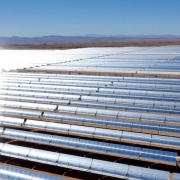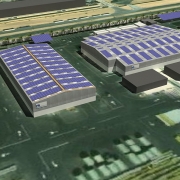Australia’s largest airport solar installation achieves practical completion
Australian engineering, procurement and construction firm, Epho Pty Ltd, announced that the 5.725MW solar system for Brisbane Airport Corporation in Australia has now officially come online. Whilst Australia’s largest commercial and industrial solar system has been operational since end of 2018, Epho Pty Ltd, which was reponsible for the project design and construction, announced on May 10 that the systems reached practical completion including all approvals from authorities.
Epho collaborated with Chinese solar PV manufacturer, Trina Solar, and Shakra Energy, Epho’s development partner.
Trina Solar provided the panels, which have an anti-glare coating that meets the requirements of aviation regulators, for five of the six sites.
- Brisbane Airport Corporation (BAC) is invested $11m in the solar PV project across six sites on the airport.
- The largest rooftop solar panel installation at an Australian airport and the largest commercial rooftop solar system in the Southern Hemisphere.
- A 6MW system, consisting of about 22,000 panels spanning an area of 36,000 square metres or more than twice the size of the Melbourne Cricket Ground (MCG).
- Brisbane Airport’s International Terminal alone will support 1.8 MW with about 6,500 panels covering more than 22,000 square metres.
- The solar system accounts for 18 percent of BAC’s direct electricity consumption, or six percent of total consumption, further complementing the savings being made through air conditioning control optimisation, lighting control upgrades and LED technology within BAC buildings, car parks and street lighting.
- The solar energy generated per year at BAC is equivalent to powering over 1,700 Australian homes for a year, with carbon offset equal to planting over 50,000 trees or taking 1,500 cars off the road each year.
“The 20,937 solar panels used in this project were spread across six sites at the airport – some were ground mounted solar panels and others were rooftop mounted. If you lay the 20,937 solar panels flat, they take up more than twice the size of the Melbourne Cricket Ground. Brisbane Airport is the most challenging project we have done, but it puts us in good stead for other airport and large commercial & industrial solar projects in the future as we have experience dealing with the various authorities.”
One of the unique requirements that airports have is for the solar panels to have minimal glare.
La Toison commented:
“In this instance, we came up with solutions that were in line with international best practices. This instilled confidence in the Australian civil aviation authority, because they knew we were committed to safety on all matters regarding the installation. We chose Trina Solar as our main module supplier because they are known for providing high-quality modules. Trina Solar also helped us significantly in the bidding process. Trina Solar has a proven track record and investment-grade bankability.”
Epho’s Managing Director Dr Oliver Hartley said:
“This 5.725MW installation is the largest airport solar deployment in Australia and shows that Australia is truly at the forefront globally of such large-scale commercial installations.”
Brisbane Airport’s energy consumption peaks during the day when the solar installation is also performing at its peak output.
Dr Hartley commented:
“This is another reason why solar energy is a natural choice for airports and other commercial and industrial enterprises.”
Trina Solar’s country Sales Manager, Govind Kant said:
“Solar energy is very worthwhile for airports, because adopting solar is in line with the worldwide push, by organizations such as Airports Council International, to reduce airports’ carbon footprint. Airports can reduce their dependence on the electricity grid considerably because they generally have a lot of land and rooftop space where solar panels can be installed.”
Govind Kant added that Epho did its own quality assurance tests of the product, prior to installation, and was very pleased with the results, as the Trina Solar panels clearly met the high standards required.
Source: Press Release by Trina Solar and Brisbane Airport website.
Photo Credit: © Nearmap Australia Pty Ltd. Brisbane Airport captured on 3 November, 2018. Work on the airport’s second runway began in 2012, and is set to open in 2020.










